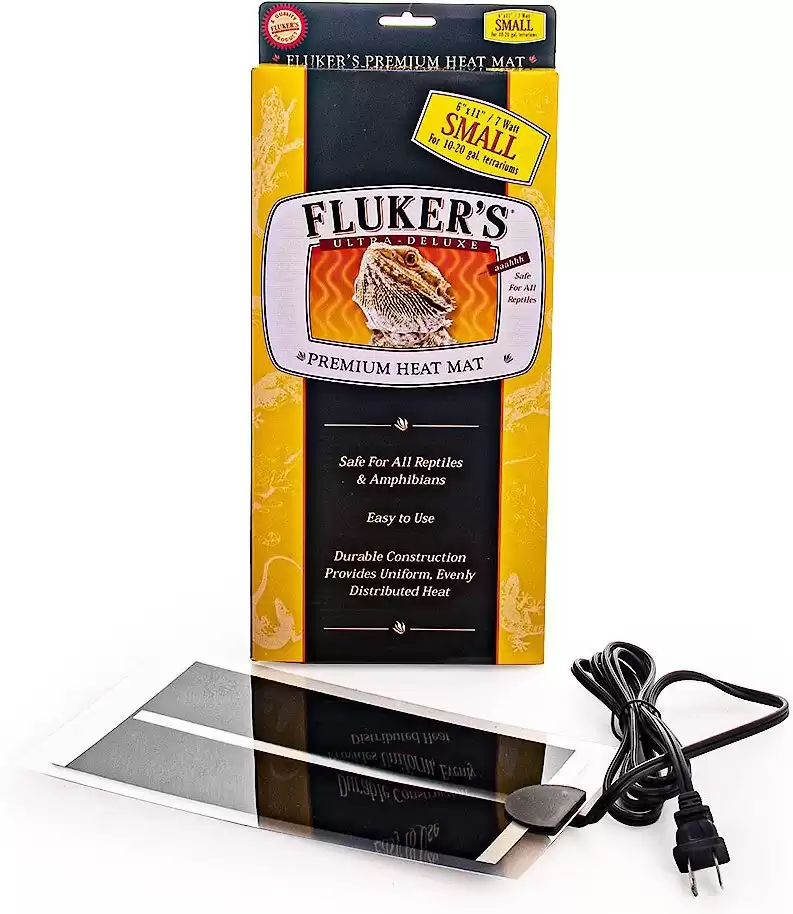| Best for | Product |
|---|---|
| Best Overall | iPower Under Tank Reptile Heating Pad |
| Best on a Budget | Fluker’s Ultra-Deluxe Premium Heat Mat |
| Best for Ease of Use | Zilla Terrarium Heat Mat Reptile Heater |
| Best Digital | Zoo Med Repti Therm Habitat Heater |
If you’re keeping a pet reptile at home, you must know there are certain elements they need in their enclosures. One of those is a heat mat. Along with incorporating a ceramic or basking bulb into your reptile’s habitat, you can set your scaly friend up with a secondary heat source. The overhead bulb mimics the heat that emanates from the sun, which is where they would normally obtain their warmth. It’s natural for reptiles to seek out a heat source that exists above them. Heating pads are a little different because they deliver heat to your reptile from below. A basking bulb or ceramic bulb along with a heat mat work in tandem. The heat mat warms the substrate at the bottom of the tank while the overhead bulb crates that warm air pressure reptiles are attracted to.
A heat mat only works for a certain area of your reptile’s tank. Reptiles need a spectrum of temperatures with an area to cool off and an area to get warm. A heat mat helps to isolate one area and make it a warming or basking area for your reptile. Allowing your reptile to choose whether to warm up or cool down is extremely important as they exercise autonomy in natural environments. The best types of heat mats already come equipped with built-in thermometers and temperature controls. Heat mats should never cover the entirety of the floor of your tank. This would create way too much heat that would make your reptile extremely uncomfortable.
To find the best heat mat for your needs, you need to consider the size and features of different heat mats. Below, we highlight the top-rated options you have so you know where to direct your attention when deciding on a final option. We give you all of the details you need about each product to help you understand whether it’s a good choice for your reptile. We also help you by providing some tips on how to choose the right heat mat and break down how to properly use a heat mat in you are reptiles habitat.
 Check Amazon
Check Amazon- Increased heating insulation due to new material
- Stays put due to adhesive paper
- It comes with a digital thermometer.
 Check Chewy Check Amazon
Check Chewy Check Amazon- Premium heat mat that is safe for use with all reptiles and amphibians
- Reliable and safe
- It can be floor or side mounted.
 Check Chewy Check Amazon
Check Chewy Check Amazon- Designed specifically to help your reptile regulate its body temperature.
- It has a maximum temperature of 113°F
- It has an energy-efficient design.
 Check Amazon
Check Amazon- Perfect for use with tortoises and other large reptile cages
- Made from an easy-to-clean, moisture-proof, and high-density polyethylene plastic
- It has an LED indicator light to show when it is switched on and working.
A-Z Animals Top Picks for Heat Mats for Reptiles
#1 Best Overall: iPower Under Tank Reptile Heating Pad
The best overall heat mat for your reptile is the iPower Under Tank Reptile Heating Pad.
This heat mat measures 8” x 12” but there are some smaller options and one larger option as well. You can pick up the heat mat plus hygrometer or heat mat plus thermostat design. We’ve highlighted the heat mat plus thermostat design here. It’s equipped with a new PTC heating material which increases insulation overall. Heat transfer is easy across the mat, and you can reach the desired temperature in just a few short minutes. It has 3M adhesive paper which provides a strong grip on the contact area. Once you place it down, it stays put.
This heat mat is ideal for use with reptiles, other small animals, amphibians, and even plant terrariums. The digital thermostat helps regulate the temperature and you can select between Celsius or Fahrenheit. It has an easy plug-in operation with LED indicator lights and a three-prong grounded plug. This design is also great for saving energy. Safety when using heat mats is extremely important and this manufacturer has rigorously tested the thermostat controller to ensure the safety of your pets.
The only drawback to this product is that you must make sure the probe for the thermometer is attached to the heating mat so that you can get an accurate reading.
Pros and Cons of the iPower Under Tank Reptile Heating Pad
| Pros | Cons |
|---|---|
| This heat mat is equipped with a new PTC heating material which increases insulation. | The probe for the thermostat must be attached to the heating pad to provide an accurate reading. |
| It uses 3M adhesive paper to provide a strong grip to the contact area. | |
| It is suitable for use with reptiles, amphibians, and plants. | |
| It comes with a digital thermometer to help you regulate the temperature. |
- Increased heating insulation due to new material
- Stays put due to adhesive paper
- It comes with a digital thermometer.
2. Best on a Budget: Fluker’s Ultra-Deluxe Premium Heat Mat
As the best budget option we recommend Fluker’s Ultra-Deluxe Premium Heat Mat.
Fluker’s offers a premium heat mat that is safe for use with all reptiles and amphibians. It’s designed to be easy to use with durable construction that provides uniform, evenly distributed heat. You can operate it at a constant 100°F and use it either inside or outside your tank. It measures 11” x 11“ and weighs only 0.6 pounds. You can mount it under or on the side of your pet’s enclosure. Just remember that if you do mount it below the enclosure, make sure there’s only a very thin layer of substrate in the tank and that there is proper ventilation to prevent heat buildup. If there is no bottom ventilation or the substrate in your reptile’s tank is too thick, the manufacturer recommends side mounting.
Unfortunately, there is no thermometer with this heat mat, so you will need to purchase one so that you can monitor the level of heat in the tank.
Pros and Cons of Fluker’s Ultra-Deluxe Premium Heat Mat
| Pros | Cons |
|---|---|
| This heat mat provides uniform, evenly distributed heat. | You will need to purchase a thermometer to check the level of heat in the tank. |
| It can be operated at a constant 100°F. | |
| It is lightweight at only 0.6 pounds. | |
| It can be used inside or outside of the tank. |
- Premium heat mat that is safe for use with all reptiles and amphibians
- Reliable and safe
- It can be floor or side mounted.
3. Best for Ease of Use: Zilla Terrarium Heat Mat Reptile Heater
It’s always a good idea to have something that’s easy to use, and that’s why we recommend the Zilla Terrarium Heat Mat Reptile Heater.
This heat mat by Zilla is available in mini, small, medium, and large sizes. This 24-watt heat mat is the ideal heat source for both desert and tropical reptiles. It’s equipped with carbon fiber which is what radiates uniform heating without any hotspots. It’s also an energy-efficient design without wires that can pinch or break. Just use the adhesive mounting either underneath or on the side of your tank. This product is designed specifically to help your reptile regulate its body temperature to enjoy a healthy life.
Your reptile needs an external heat source to elevate its body temperature. This Zilla heat mat provides that warm heat your reptile needs to absorb from its surrounding environment. Without a proper heat source in the tank, your reptile is thrown off kilter. This could affect his activities, digestion, and appetite. Each one of these units has an adhesive backing and is low voltage with a maximum temperature of 113°F.
Unfortunately, some customers reported that the adhesive backing does not stick very well if you are trying to mount the pad to the side of the tank.
Pros and Cons of the Zilla Terrarium Heat Mat Reptile Heater
| Pros | Cons |
|---|---|
| This heat mat is equipped with a carbon filter to ensure that there is an even distribution of heat. | Some customers reported that the adhesive backing is not good enough to stick the pad to the side of the tank. |
| There are four sizes available. | |
| It has a maximum temperature of 113°F. | |
| It has adhesive backing so that it can be securely attached to the tank. |
- Designed specifically to help your reptile regulate its body temperature.
- It has a maximum temperature of 113°F
- It has an energy-efficient design.
4. Best Digital: Zoo Med Repti Therm Habitat Heater
As the best digital option we suggest the Zoo Med Repti Therm Habitat Heater.
This Zoo Med laboratories 40 watt habitat heater is made from an easy-to-clean, moisture-proof, and high-density polyethylene plastic. It’s equipped with metal protection on the power cord which adds an extra layer of safety for both you and your reptile. This design is perfect for use with tortoises and other large reptile cages. It has a convenient LED indicator light that lets you know when the heater is on and working. There’s also automatic thermostat protection that shuts this heat mat off at 119°F to help prevent overheating. This is an ultra-valuable feature for your reptile’s safety.
Unfortunately, some customers reported that the temperature of this mat can fluctuate so they recommend purchasing a thermometer so that it can be monitored.
Pros and Cons of the Zoo Med Repti Therm Habitat Heater
| Pros | Cons |
|---|---|
| This heater is made from high-density polyethylene plastic. | The temperature of the mat can fluctuate so it is recommended to purchase a thermometer to monitor it. |
| It is easy to clean. | |
| It has metal protection on the power cord for safety. | |
| There is an LED indicator light to show when it is switched on and working. | |
| It has an auto shut-off feature at 119°F to prevent overheating. |
- Perfect for use with tortoises and other large reptile cages
- Made from an easy-to-clean, moisture-proof, and high-density polyethylene plastic
- It has an LED indicator light to show when it is switched on and working.
Choosing the Best: What to Look For
Your reptile needs a solid heat source to survive and thrive. However, not every heat mat is designed in the same way. They vary in wattage, output, quality, and extra features. Nevertheless, there are a few things that you should consider before purchasing a heat mat for your reptile. For one, it should be specifically made for reptiles. You should not be using any other type of heat mat in your reptile tank. Your heat mat should also have safety features like automatic shut off after a certain temperature is reached. The wattage should always be somewhere between four and 24 watts as well.
The reason you shouldn’t use any other type of heat mat unless it’s specifically designed for reptiles is because these products are usually preconfigured to stay within a certain heat range. For example, you could potentially find a cheaper product that’s meant for industrial work. Yes, you’ll save up front, but those heat pads are not designed for reptiles and quickly overheat, making your reptile uncomfortable, or worse.
You can always purchase a thermostat separately from your heat mat or you can purchase an option that has this built-in feature already. A thermostat works as a safety feature to automatically shut off the heat pad if it goes past a certain temperature setting. Any time you’re using a heat source, even when it’s high-quality, you should always remain vigilant. A thermostat helps keep you abreast of your reptile’s environment so you can make real-time adjustments as needed.
When we talk about the wattage range, it’s because the wattage of your heat mat is ultimately what determines just how hot the mat will get. Generally, larger heat mats get hotter than some of the smaller options though that is not always the case. Using improper wattage for your reptile’s needs can lead to having the wrong temperature settings for your reptile. If the temperatures don’t get high enough, your reptile may become slow and sluggish. Additionally, this may cause issues with your reptile’s digestive system. On the other hand, if it gets too hot, your reptile can suffer from respiratory infections, or all the symptoms related to dehydration.
To give you an idea of how to shop, consider that a 20-gallon tank would do well with eight watts. If you have a much larger tank that’s about 50 or 60 gallons, then you’ll need something like 24 watts. A smaller 10-gallon tank can operate well with four watts. Knowing the wattage can help narrow down your choices. If you have a 10-gallon tank, go for four watts and a heat mat that measures about 4” x 5.” If you are in the 20-gallon range, you’ll need a heat mat that is somewhere closer to 6” x 8.” For a super large 50 or 60-gallon tank, purchase a heat mat that measures 8” x 18.” If it’s too small, your reptile won’t have enough of a temperature gradient for comfort. If it’s too big, it creates the same issue but with not enough of a cool space for your reptile to enjoy.
How to Properly Use a Heat Mat for Your Reptile
Each of these top-rated heat mats is designed for ease of use and durability. They shouldn’t require too much figuring out upon delivery. To create the best experience for your reptile, you should position your new heat mat on the tank before you add any other products like substrate. Remember, you have to create a temperature gradient inside the tank so usually, the best place for your heat mat is beneath the overhead heat source. This way, your reptile can warm up and absorb the UV rays it needs to remain healthy. When you have the basking bulb directly above the heat mat, you create an ideal environment where you are killing two birds with one stone.
Once you figured out the best configuration for your heat mat alongside your basking bulb, go ahead and remove the protective cover of the adhesive on your heat mat. Go ahead and add the heat mat to your desired location and make sure that it doesn’t cover more than half of the tanks floor. Then, you can turn it right side up and begin adding your substrate. Remember not to use too much substrate because then the heat will not be able to emanate as effectively upward for your reptile. If you purchased a heat mat that comes with the temperature probe, go ahead and insert it down into the substrate just above where you’ve placed the heat mat. Remember that if the probe is too far from the heat mat, the temperature reading won’t be accurate, which can cause the thermostat to communicate to the heat mat that it needs to create more heat. This may not actually be the case and could become dangerous.
You may want to consider adding an extra, independent thermometer, so you have a different temperature reading to confirm the temperature reading of the built-in thermometer for your heat mat. After installing a heat mat for the first time, you’ll want to keep an eye on it. Keep checking back regularly to make sure that the temperature is staying within the appropriate range. Once you have confirmed that everything is working properly, you can move forward with setting up the rest of the habitat and introducing your reptile to its new and improved enclosure.
| Best for | Product |
|---|---|
| Best Overall | iPower Under Tank Reptile Heating Pad |
| Best on a Budget | Fluker’s Ultra-Deluxe Premium Heat Mat |
| Best for Ease of Use | Zilla Terrarium Heat Mat Reptile Heater |
| Best Digital | Zoo Med Repti Therm Habitat Heater |
The Top Rated Heat Mats for Your Reptile FAQs (Frequently Asked Questions)
Are heat mats good for reptiles?
Heat mats aren’t just good for reptiles, they’re necessary! Your reptile relies on external heat sources to regulate its body temperature. Without a heat source in its enclosure, your reptile won’t be able to remain healthy.
Do reptile heat mats cause fires?
If it’s a properly designed and manufactured heat mat, it should not cause a fire. Some heat mats are equipped with extra safety features as well, like automatic shut-off when it reaches a certain temperature.
What is the best heat mat for a ball python?
Ball pythons love belly heat, so make sure you select a heat mat that fits the enclosure you’ve set up for it. Remember not to purchase a heat mat that takes up more than half of the floor space of your tank.
What temperature should a reptile heat mat be?
That depends on the type of reptile you have. Make sure you are selecting the appropriate temperature based on your reptile’s unique needs.
Thank you for reading! Have some feedback for us? Contact the AZ Animals editorial team.




